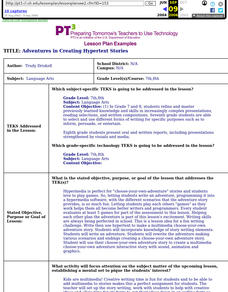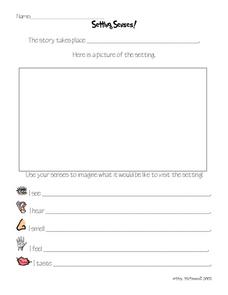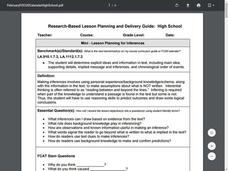Curated OER
Identify the Element of Line
Students explore the element of "line." In this beginning art lesson, students listen to the book Harold and the Purple Crayon, then describe the types of lines Harold drew. Students identify straight lines, jagged lines, curvy...
Curated OER
Adventures in Creating Hypertext Stories
Use hypertext to make a multimedia choose-your-own adventure story! Young writers incorporate knowledge of story writing elements to write their own stories, and rewrite the adventure with various scenarios and endings. Use technology to...
Curated OER
Cinderella
Explore positive and negative character traits and universal themes in the story of Cinderella with primary learners. Story elements are reviewed and discussion questions are listed. Learners practice retelling the story and begin a...
Curated OER
The "Write" Stuff: Strategies and Conventions for Imaginative Writing
A comprehensive and immersive series of lessons that examines various aspects of story development leads learners into writing a narrative of their own. Writers develop an understanding of the writing process as they use the learning...
Curated OER
Borrowing Narrative Skills from Mr. Fletcher: Using a "Prompts in Reverse" Technique to Inspire Your Writers
Help your class find their writing voices with this lesson which uses the work of Ralph Fletcher to guide a "Prompt in Reverse" activity. Using the chapter "First Pen" from Fletcher's Marshfield Dreams, learners decipher what they...
Indian Land Tenure Foundation
Tribal Origin Stories
The teacher reads and retells Californian tribal origin or creation stories that come from the traditions of a variety of California Indian tribes. Then, pupils get together in groups and retell the stories they just heard; just as...
Curated OER
Setting And Plot
Pupils engage in study of plot and setting with the reading of many familiar texts. They identify the plot and setting with the help of a worksheet. The teacher works with the class for scaffolding and helps them to recognize the concepts.
Curated OER
Circular Story Map
In this story elements map worksheet, students use the blank graphic organizer to plan a story they will write. Students will write a story that takes place in the country they choose to study. Students think of the setting, characters,...
Curated OER
Setting Senses!
In this senses learning exercise, students write what the setting of a story is, and then draw a picture of the setting. Students then imagine what it would be like to visit the setting, and list things they might see, hear, smell, feel...
Curated OER
The World Around Me
Combining visual and language arts, here is a resource that prompts middle schoolers to write stories based on pictures of their surroundings. They use digital cameras to take pictures of favorite areas in the school. Next, they choose...
Curated OER
Understanding Fantasy
Explore fantasy as a genre. After working in small groups to identify literary elements in The Lion, the Witch, and the Wardrobe by C.S. Lewis, class members share their work and then use the presentations to help them prepare to write...
Curated OER
Introducing Literary Elements in Fiction
Identify literary elements in fiction. In this reading comprehension lesson, learners read the book Pigsty and record literary elements onto a graphic organizer. They specifically discuss the main characters and events in the text.
Curated OER
Puss in Boots/Jamil and the Clever Cat
Second graders read the story PUSS IN BOOTS identifying main characters, setting, and significant events. They then read the story JAMIL AND THE CLEVER CAT and compare it with the story PUSS IN BOOTS compiling a list of characters,...
Curated OER
Introduction to Drama
Introduce your class to drama! You cast each pupil as a different character from a story you have read. They are given a general outline of the scene, act out the scene multiple times, then discuss the weak and strong aspects of each...
Curated OER
Writing Scripts
Create a classroom full of writers using this innovative technique. The presentation walks learners through the process of writing a script, including identifying the setting, characters, and major events in the story. After reviewing...
Curated OER
The Sand Horse
Fourth graders are introduced to the book THE SAND HORSE and discuss the title and cover illustration. They listen to the story listening for words and phrases to describe the setting. They then brainstorm key words to illustrate the...
Curated OER
Lesson Plan 2: Good Novel, Bad Novel
What are the characteristics of a good piece of writing? What makes a story interesting? Give your pupils a chance to define the qualities of good novels and what they see as the qualities of bad novels. Class members record these...
Curated OER
Cops and Robbers
Second graders observe the teacher model writing a letter to the author of the book, COPS AND ROBBERS. They then compare the story structure of the book to those of FUNNYBONES and identify the setting, characters and theme.
Curated OER
Literary Elements: Storytelling Techniques
Learners think about what makes a story interesting to read or hear. What kinds of details make a story come to life? How can a storyteller create a feeling of excitement or suspense? What kinds of characters do students like? If anyone...
Emotional & Behavioral Disorders and Learning Disabilities
Narrative Story Elements Matrix
Readers use a story elements matrix to identify the title, setting, characters, point of view, problem, and solution in four narratives. The template could be used to prepare for a compare/contrast exercise.
Curated OER
Story Stew -- Teaching Character, Plot, And Setting
Students examine the story elements of characters, plot, and setting. They identify the story elements from various "ingredients" taken out of a pot, and add their own story element "ingredients" on index cards into the pot.
Curated OER
Scary Short Story Writing Lesson
There's nothing like the prospect of writing a scary story to get your middle schoolers' writing juices flowing! In the lesson presented here, pupils listen to scary short stories read to them by the teacher. Then, a discussion ensues...
Curated OER
The Similarities and Differences of Setting
Sixth graders identify components of the setting in science fiction text. In this compare and contrast settings instructional activity, 6th graders read Only You Can Save Mankind and identify similarities and differences between...
Curated OER
Mini-Lesson Planning for Inferences
Making inferences and drawing conclusions is a key component to successful active reading. Encourage your class to use context clues and prior knowledge to infer different elements of a story, including the setting, plot, and character...























